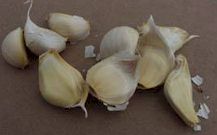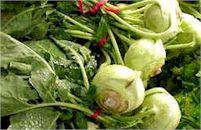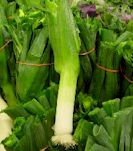|
|
|
 |
Collards
Only firm, dark green leaves
are fit for consumption; any wilted or yellowish leaves
must be discarded. The leaves are poorly digestible when
raw and cannot be used in salads. Do not wash until
ready to use, watch for sand on the back of the leaves.
Collard greens are a basic food of the Southern United
States cuisine. They may actually be prepared with other
|
|
similar green leaf
vegetables, such as kale, turnip greens, spinach, and
mustard leaves in "mixed greens". They are generally a
"winter" dish in the South. |
 |
Corn
When
selecting, look for husks that have good green coloring
with pale colored silk. To check the freshness, pull the
top of the husk away from the ear and pierce a kernel
with your fingernail. If the kernel releases a slightly
cloudy juice it is typically a fresh batch. If the
kernels are dented or discolored, the corn is not fresh.
For the best sweet corn, no more than 3 hours from
picking to serving. |
To store corn, leave the corn in the husk and
refrigerate as soon as possible. If corn has been
husked, place it in a plastic bag and store in the
refrigerator. Shuck the corn by peeling back the husk
and completely removing it. Remove the thin
silk that runs along the kernels of
the corn with a vegetable brush or with a damp paper
towel. |
 |
Cucumber
Look for
cucumbers that are very firm and rounded right to the
ends; avoid any with withered, shriveled tips. Although
the overall size varies with the type, slender cukes
typically have fewer seeds than thick ones. Their skin
should be a rich green not extremely pale and definitely
not yellow. Watch for bruises or |
dark spots, soft cucumbers
are a sign of age.
There are several ways to remove the bitterness
cucumbers sometimes have. Try cutting off the ends and
and rubbing the flat of the knife across the cut end,
then peel the skin. If that does not work, sprinkle the
peeled cucumbers with a pinch of salt, a pinch of sugar,
and a few drops of vinegar, and let stand for 20 to 30
minutes. Many store bought cucumbers
have a wax coating, wash well if leaving the skin on. |
 |
Eggplant
Smaller,
immature eggplants are best. Full-size puffy ones may
have hard seeds and can be bitter. Choose a firm,
smooth-skinned eggplant that is heavy for its size;
avoid those with soft or brown spots. Gently push the
flesh if it gives slightly but then bounces back, it is
ripe. If the |
indentation remains, it is
overripe. If there is no give, the eggplant was picked
too early. Also make sure an eggplant isn't dry inside,
knock on it with your knuckles a hollow sound indicates
dryness.
Eggplants are very perishable and become bitter with
age. They should be stored in a cool, dry place and used
within a day or two of purchase. When young, the skin of
most eggplants are edible; older eggplants should be
peeled, since the flesh discolors
rapidly, an eggplant should be cut just before using. |
|
 |
Garlic
Garlic is most often used as
a seasoning or a condiment. When crushed or finely
chopped it yields allicin, a powerful antibiotic and
anti-fungal compound (phytoncide).
Garlic is
widely used in many forms of cooking for its strong
flavor, which is considered to |
|
enhance many other flavors. Depending on the form of
cooking and the desired result, the flavor is either
mellow or intense. It is often paired with onion and
tomato.
In culinary preparation, it is necessary to remove the
parchment-like skin from individual cloves before
chopping. Lightly crushing the cloves with the ball of
the hand or flat of a knife makes this job much easier.
When eaten in quantity, garlic may be strongly evident
in the diner's sweat and breath the following day. |
|
 |
Kale
Choose leaves that are crisp
and fresh and have a deep green color, with no yellow
tinge. Smaller leaves have a milder flavor, can be
cooked whole, and often have stems tender enough to eat.
With larger leaves, you'll need to cut out and discard
the stems, and then chop the leaves into small pieces.
Leafy greens are in season
in the winter months, |
|
but tend to be available
year-round.
Store kale in dry plastic bags in the refrigerator for
up to three days. You can also cook the greens, and
store them in the freezer in sealed plastic bags.
They'll keep for months, so you can use them
spontaneously in soups or
casseroles. |
|
 |
Kohlrabi
Trim leaves if they are
still attached to the bulb. The bulbs should be stored,
unwashed, in a plastic bag. They will hold for about a
week in the refrigerator. Smaller kohlrabi are the
sweetest and most tender. Bulbs much bigger than the
size of a tennis ball won't be as tasty and often have a
pithy flesh. |
|
Tender, young kohlrabi is
delicious eaten raw. Peel the outer skin with a paring
knife. Slice, dice, or grate, and add to salads. Use on
raw vegetable platters or serve with a creamy dip.
Grated kohlrabi can be added to slaw, but lightly
salt it first and let stand for
several minutes. |
|
 |
Leek
Leeks should be firm and
straight with dark green leaves and white necks. Good
quality leeks will not be yellowed or wilted, nor have
bulbs that have cracks or bruises. Try to purchase leeks
that are of similar size so as to ensure more consistent
cooking if you are planning on cooking the leeks whole.
Fresh leeks should be stored unwashed and untrimmed in
the refrigerator, where they will keep fresh for between
one and two
weeks. Wrapping them loosely
in a plastic bag |
|
will help them to retain
moisture.
The leek is a member of the onion family, but is milder
than either onions or garlic. Unlike onions or garlic,
leeks do not form bulbs or produce cloves but develop an
edible 6 to 10 inch long round stem as much as 2 inches
in diameter. The leek has leaves very similar to garlic.
They are flat rather than round and hollow like onion
leaves. Leeks are available throughout the year they are
in season from the fall through the
early part of spring when they are at their best.
|
|
 |
Lettuce
Iceberg lettuce is the most
popular lettuce in the United States. Dark green lettuce
leaves always indicate higher fiber, flavor and
nutritional value.
Lettuce leaves should be free of wilt, rot and rust.
Wrap fresh, unwashed leaves in plastic warp and store in
the refrigerator for a few days if necessary. Cooler
temperature |
|
will keep lettuce fresh
longer. The coolest part of most refrigerators is
usually on the first shelf against the rear wall.
Avoid storing lettuce with apples, pears or bananas.
These fruits release ethylene gas, a natural ripening
agent, that will cause the lettuce to develop brown
spots and decay quickly. Toss
lettuce that looks slimy or has black spots. |
|
 |
Okra
Refrigerate unwashed, dry
okra pods in the vegetable crisper, loosely wrapped in
perforated plastic bags. . Wet pods
will quickly mold and become slimy. Okra will keep for
only two or three days. When the ridges and tips of the
pod start to turn dark, use it. Once it starts to
darken, okra will quickly deteriorate. |
|
Okra may be steamed until tender, either whole or sliced about 1/e thick.
Okra can also be boiled with tomatoes, fried in a
cornmeal batter, or simply stir-fried. Okra can also be
the thickening agent in gumbo.
Okra is a mucilaginous plant it gives off a
slippery/sticky substance when cut. This substance gives
okra it's thickening properties. This is why it is so
useful in soups and stews. When used raw or as a
vegetable it shouldn't be cut into too small pieces, as
the more it is cut, the stickier it becomes. Because of
the slippery substance is what most
people don't like about okra. |
 |
Onion
Onions are
available in fresh, frozen, canned, and dehydrated
forms. Onions can be used, usually chopped or sliced, in
almost every type of food, including cooked foods and
fresh salads, and as a spicy garnish; they are
rarely eaten on their own but usually act as
accompaniment to the main course. |
- Depending on the
variety, an onion can be sharp and pungent or mild
and even sweet.
- Chopped, it is one
of the three vegetables considered the holy
trinity of Louisiana Creole and Cajun cuisine.
- Cocktail onions, or
pickled pearl onions, are used to garnish drinks
such as Gibsons.
|
Artichoke - Celery
Collards - Onion
Parsnips - Turnips
|
|